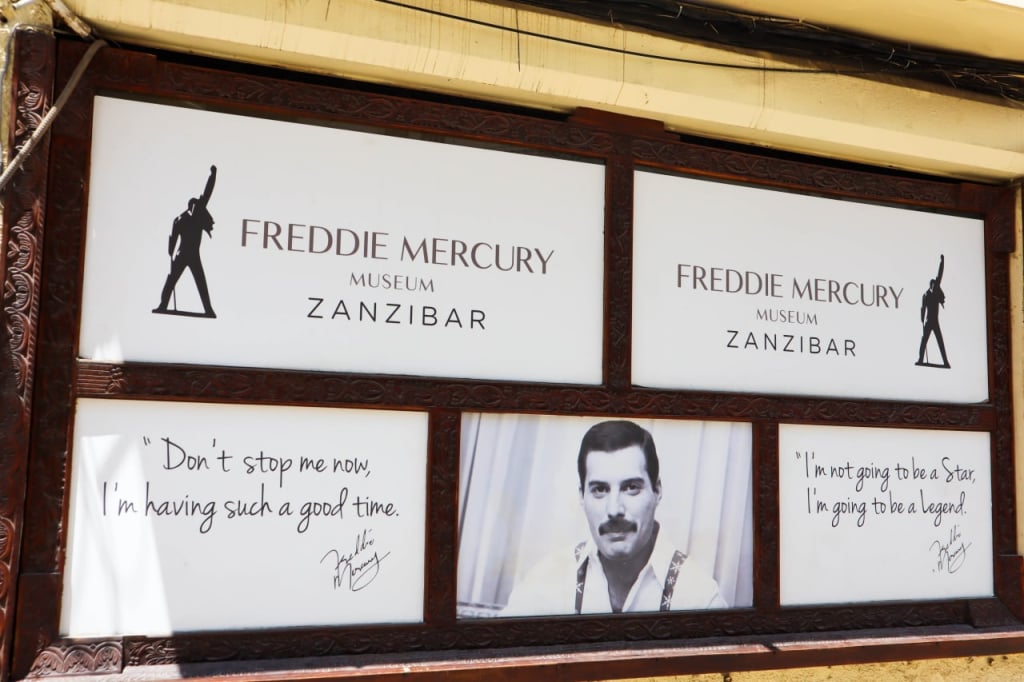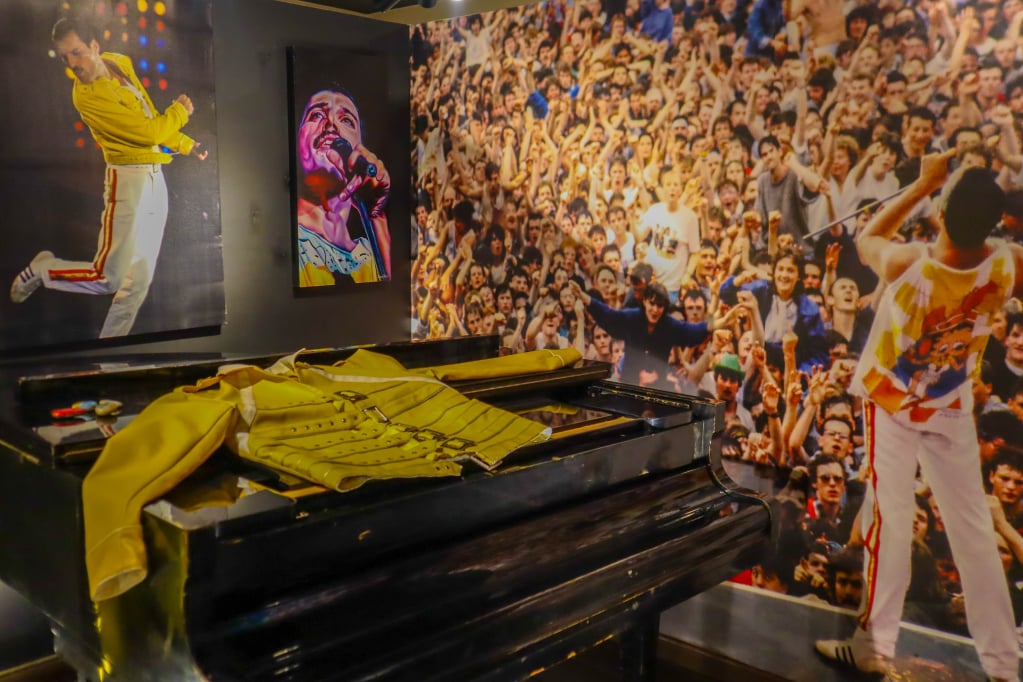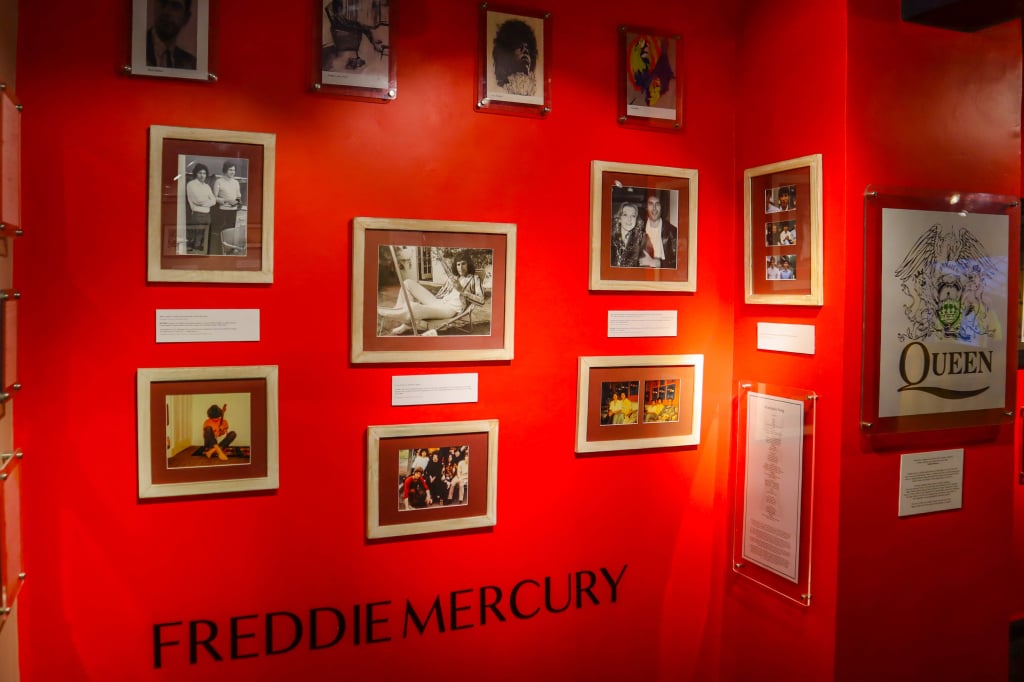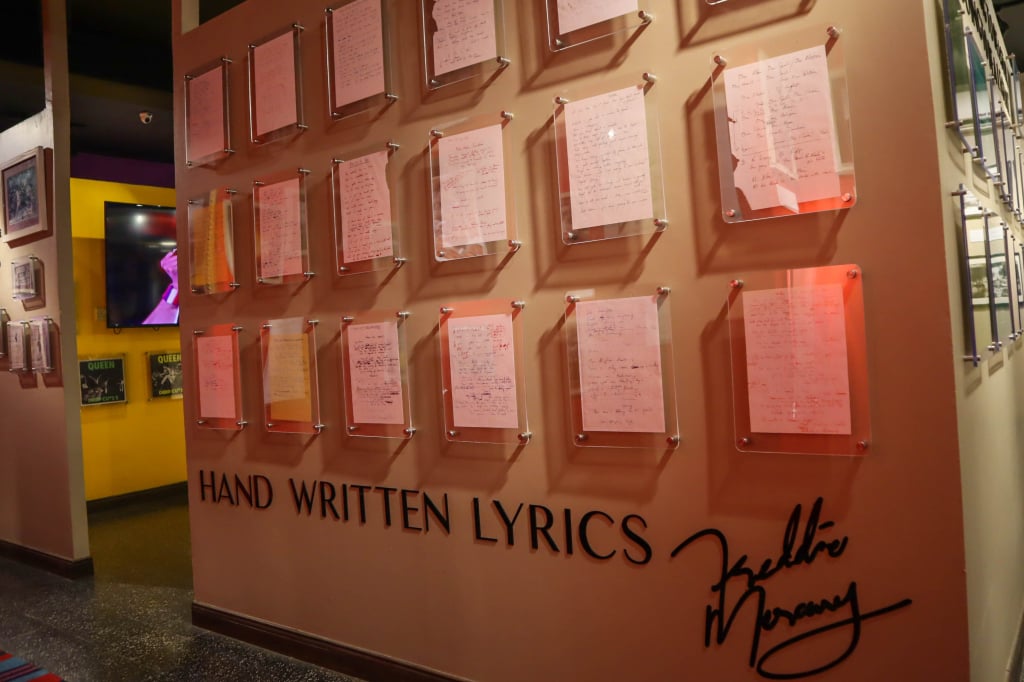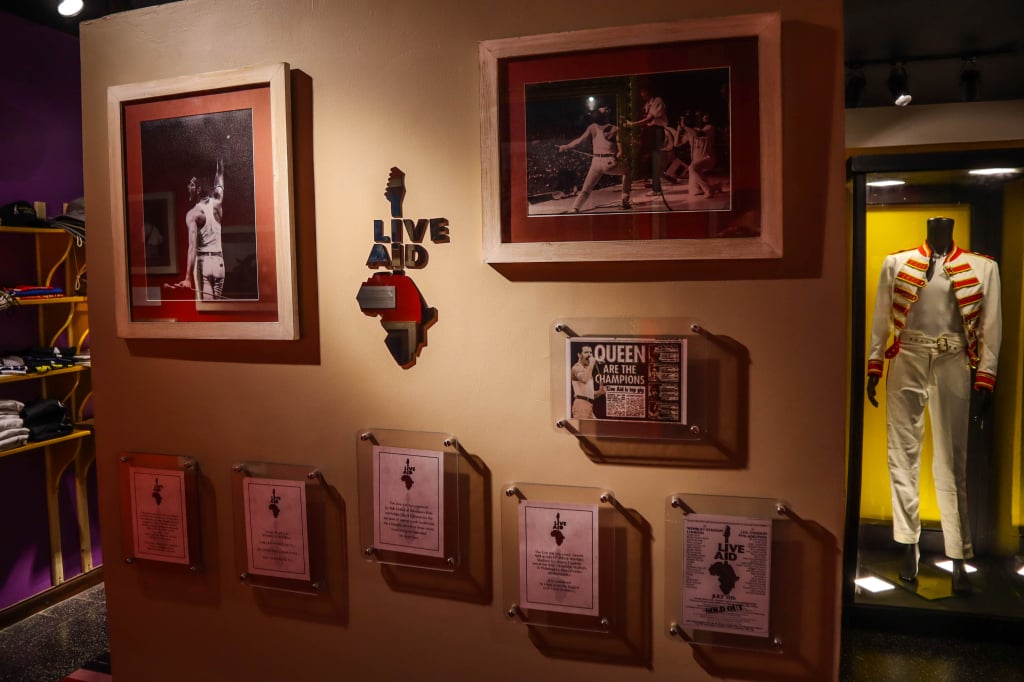Apart from a fantastic beach vacation, Officially, Zanzibar is an archipelago of 75 islands. Zanzibar is also referred to as a political and administrative entity, a semi-autonomous region within Tanzania, and the capital of the autonomous state. The largest island is officially named Unguja, but it is commonly called "Zanzibar" both in Tanzania and English-speaking communities. For the sake of simplicity, we will also refer to the famous tourist destination as simply ‘Zanzibar’. (Tanzania) offers travelers who visit Stone Town several interesting museums, one of which is the Freddie Mercury Museum. Zanzibar is the childhood home of the rock icon, and the museum is located in the house where the Queen lead singer was growing up. This cozy museum is filled with items that tell the story of the earliest part of Freddie Mercury’s life, and the whole place carries the energetic vibe of the singer.
Freddie Mercury House, Stone Town, Zanzibar
On a street near the Post Office in the old Stone Town, Zanzibar, a passer-by might notice a bright three-story building. Sometimes tourists stop here to take photos of the beautiful facade or pose for selfies with the carved door as the background. But, if you walk closer, you will see a sign that reads "Freddie Mercury Museum Zanzibar" with a recognizable silhouette: a man stands with his legs spread wide apart, holding the microphone stand with one hand and raising his fist up with the other- the iconic stance of Queen’s lead singer, Freddie Mercury.
Posters that decorate the windows are of a handsome man with a thick mustache - Freddie Mercury himself, the rock legend, whose fame and popularity have not diminished even decades after his passing. From the example of this guy's life, you can clearly see why such people are called stars. And as if to continue this thought, you read a quote from the lead singer of Queen: "I'm not going to be a star, I'm going to be a legend."
Freddie Mercury is perhaps the world's most famous native of Zanzibar. The museum collection contains original photos donated by his family and loved ones, as well as other artifacts sent to the museum by Queen Productions Ltd. directly from the UK. The museum is always playing Queen music and you can hear Freddie's voice. The atmosphere plunges you into the world of the Great Pretender, who found both Zanzibar and Great Britain to be too small, so he created his own world through music.
The building of the museum itself also carries historical value for Queen fans. It was the home of Freddie Mercury until his family, the Bulsaras, left the island during the time of the In January 1964, after gaining independence from Britain a month earlier but still remaining a sultanate, Zanzibar rebelled against the authority of the Arab sultan. Within hours, the rebels seized key facilities in the capital. The sultan and his family, as well as members of the government, managed to escape. This was followed by riots and massacres of the Arabs, Indians, and Europeans on the islands of the Zanzibar archipelago. Many people, including the Bulsara family, had to flee Zanzibar. The house’s steps and walls still hold the memory of the naughty boy who was later recognized and loved by the entire world. Now, from these very walls, photographs and memories of eyewitnesses tell of the time and place where the Star was born.
When Freddie Mercury was Farrokh Bulsara
The Freddie Mercury Museum is only a few years old. Its creators were inspired by the success of the "Bohemian Rhapsody" film. The key objective of the museum was to tell the story of where and how Freddie Mercury’s personality developed. The museum did not have much space to share the whole archive and create an impressive setting - only one spacious room is allocated for the exposition, while the rest of the house functions as a hotel.
Within that small space, museum founders Andrea Boero and Javed Jafferji have managed to immerse visitors in the world of Freddie Mercury's childhood and adolescence, when he was still known under his given name, Farrokh Bulsara. The early childhood part of the exhibit is the most vivid; it shows the old Stone Town under British and Arab rule and the streets where Farrokh and his friends used to go to school, run to the beach after class and swim in the Indian Ocean.
As a child, Farrokh was greatly influenced by the traditions of Zoroastrianism which was practiced by his Parsis are an ethnic group of Iranian origin that left Persia in large numbers in the 8th and 9th centuries when the Arabs imposed Islam on the local population. Parsis are united by their affiliation to Zoroastrianism, a religion based on the teachings of Zarathustra. Most of the Parsis fled to South Asia, primarily to India. Today there are more than 100,000 people in the world who consider themselves Parsi parents. Some aspects of Zoroastrian cultural traditions are also presented to the museum visitors - one can see how the Parsis dressed in the 1940s, and how the rituals took place in the now-demolished Zoroastrian temple which little Farrukh often visited as well. During the infancy of the future musician, about 300 Parsis lived in Stone Town, but now it is believed that only two remain in Zanzibar.
Preserving the history of Freddie Mercury's connection to the colorful culture of Zanzibar - this was achieved by the little museum in Stone Town. In the archive pictures there you can see Freddie as a baby posing on a pouf in a photo studio (fun fact: that photo studio still operates on Shangani Street and is owned by the son of the photographer who took this picture). In another, you can see Sabin, a dark-skinned nanny walking in the backyard with a smiling baby in a stroller, and finally Freddie as a five-year-old boy with a festive wreath around his neck standing in the garden of his family home, celebrating the Parsi New Year's Day.
Looking at the photographs, reading the captions, and delving into the memories of Freddy's sister Kashmira, who helped the museum in the early days, is a real treat for the curious tourist. Those will thrill Freddie Mercury fans, and any tourists looking for something a bit different during their Stone Town tour.
A small museum, yet a great pleasure
The museum in Zanzibar is a must-visit for those who consider themselves fans of Queen and Freddie Mercury - and for anyone else interested in exploring the iconic spots of the island.
To help you get the most out of your tour of this museum, here are a couple of tips to keep in mind:
Choose the hottest time of the day
Stone Town is located near the equator and it is hot year-round. Inside the maze of the old Stone Town, you are unlikely to experience much of a sea breeze, so you will certainly feel the heat and humidity even more than if you were at the oceanfront. You’ll enjoy this museum more if you also use it as a respite from the sun’s sweltering heat around mid-day, as it is well air-conditioned.
Plan your visit for the hottest part of the day, and take your time walking around the photo galleries. Look at the pictures, contemplate the lyrics, and enjoy the cool air along with Queen’s music. Stick around the spot where concert recordings are broadcasted on a screen to get a little more out of your time at the museum.
Refrain from reading reviews before you go
Quite often, people carelessly review the places and sites they've been to. You can find a bulk of info about the Freddie Mercury Museum in Stone Town online, too, but not all reviews are worth reading. We advise you not to read anything at all but to simply go to the museum and see it with your own eyes.
Some tourists see the building itself, take pictures hastily, and go into the hotel instead of the museum and therefore leave disappointed. Others expect to see a rare exhibit of Mercury’s personal belongings, but neither the piano nor the recognizable jackets and suits impress them. Others walk through the room briefly but take their time to write a negative review. Only thoughtful and attentive visitors write something worthwhile.
It makes more sense to consider the museum where the Bulsara family lived as part of the greater Stone Town and Zanzibar history, and as an excellent addition to other Zanzibar museums which include the Old Slave Market and Anglican church, as well as the House of Wonders and other Zanzibar culture exhibits. Visiting all of the museums provides a more well-rounded perspective on the diverse history of Zanzibar.
Keep Calm and Pole Pole
Throughout Tanzania and Zanzibar, you’ll likely hear the phrase "pole pole". This is Swahili for “slowly, slowly” and reflects the local philosophy of a leisurely life without hurry or worry. That’s probably the best rule for visiting the Freddie Mercury Museum: to go slowly and take it all in. The longer you stay, the more details you will see, and therefore, the better your experience will be. It is likely that the museum might spark a new wave of interest in the musician’s personality, even in those who are not huge fans of rock music or Queen.
Here are a couple of quizzes for your stay at Freddie Mercury Museum from Altezza Travel, to make it more fun and to test your attention to detail:
- When in the museum, look for a star similar to the stars on the Hollywood Walk of Fame;
- Spot errors in Freddie’s birth certificate made by a hasty hospital registrar;
- Find the memoirs of Farrukh's friend named Bonzo and read about three top places where Zanzibar teenagers used to cycle (one of them is a must-visit on a separate excursion - the caves where slaves were confined);
- Search for a review sheet written in your native language - there is a suggestions board behind the souvenir exhibit, or write your own if you can’t find one in your language.
What else you can see in Freddie’s museum
The exhibit is divided into several visually distinct sections. At the entrance, you are introduced to Stone Town's past, which smoothly brings you to the time when the Bulsara family had their firstborn child. The following sections correspond to the periods when Freddie Mercury studied in Panchgani in India, his first musical successes after he moved to the UK, the popularity of Queen, and the last years of the musician's life when he was already seriously ill.
One of the most remarkable sections displays a collection of drafts with song lyrics. Queen fans can see their favorite lines here, written in the author's own hand. Under the band's logo, there is a story of its creation told by the artist himself - Freddie Mercury, who studied at an art school and was an excellent painter.
Closer to the end of the exhibit, you can read the touching story of the artist's last song, Mother Love, told by his bandmate and Queen’s lead guitarist, Brian May. Next to it, there are framed prints of photos of Brian May himself. The photo shows Brian visiting a newly opened museum and other places in Stone Town where Freddie spent his childhood days. Brian May said that he had dreamed of visiting Zanzibar his whole life, so this experience was a dream come true.
If your dream is the same as Brian May’s, perhaps it is the best reason to visit Zanzibar.
And we haven’t even told you about everything else that you can find on Shangani Street! It is impossible to put everything you can see and experience there into words. Getting to the museum yourself is the only way you can feel that the show must go on!












